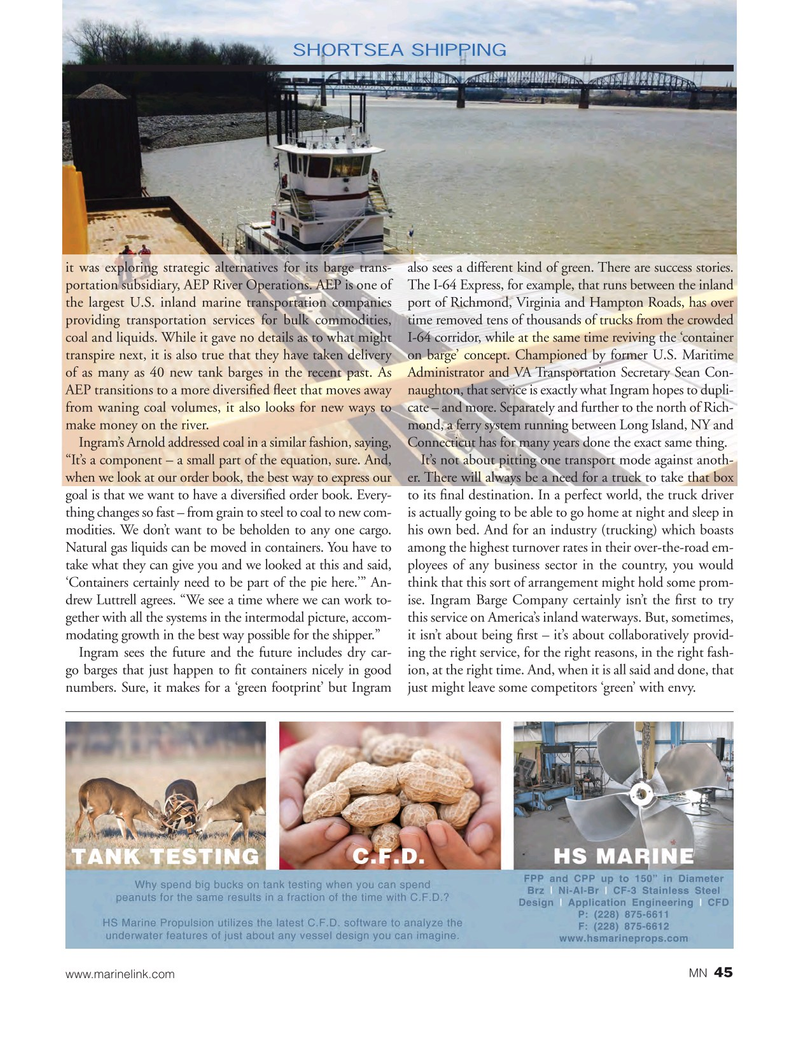
Page 45: of Marine News Magazine (June 2015)
Combat & Patrol Craft Annual
Read this page in Pdf, Flash or Html5 edition of June 2015 Marine News Magazine
SHORTSEA SHIPPING it was exploring strategic alternatives for its barge trans- also sees a different kind of green. There are success stories. portation subsidiary, AEP River Operations. AEP is one of The I-64 Express, for example, that runs between the inland the largest U.S. inland marine transportation companies port of Richmond, Virginia and Hampton Roads, has over providing transportation services for bulk commodities, time removed tens of thousands of trucks from the crowded coal and liquids. While it gave no details as to what might I-64 corridor, while at the same time reviving the ‘container transpire next, it is also true that they have taken delivery on barge’ concept. Championed by former U.S. Maritime of as many as 40 new tank barges in the recent past. As Administrator and VA Transportation Secretary Sean Con-
AEP transitions to a more diversi? ed ? eet that moves away naughton, that service is exactly what Ingram hopes to dupli- from waning coal volumes, it also looks for new ways to cate – and more. Separately and further to the north of Rich- make money on the river. mond, a ferry system running between Long Island, NY and
Ingram’s Arnold addressed coal in a similar fashion, saying, Connecticut has for many years done the exact same thing.
“It’s a component – a small part of the equation, sure. And, It’s not about pitting one transport mode against anoth- when we look at our order book, the best way to express our er. There will always be a need for a truck to take that box goal is that we want to have a diversi? ed order book. Every- to its ? nal destination. In a perfect world, the truck driver thing changes so fast – from grain to steel to coal to new com- is actually going to be able to go home at night and sleep in modities. We don’t want to be beholden to any one cargo. his own bed. And for an industry (trucking) which boasts
Natural gas liquids can be moved in containers. You have to among the highest turnover rates in their over-the-road em- take what they can give you and we looked at this and said, ployees of any business sector in the country, you would ‘Containers certainly need to be part of the pie here.’” An- think that this sort of arrangement might hold some prom- drew Luttrell agrees. “We see a time where we can work to- ise. Ingram Barge Company certainly isn’t the ? rst to try gether with all the systems in the intermodal picture, accom- this service on America’s inland waterways. But, sometimes, modating growth in the best way possible for the shipper.” it isn’t about being ? rst – it’s about collaboratively provid-
Ingram sees the future and the future includes dry car- ing the right service, for the right reasons, in the right fash- go barges that just happen to ? t containers nicely in good ion, at the right time. And, when it is all said and done, that numbers. Sure, it makes for a ‘green footprint’ but Ingram just might leave some competitors ‘green’ with envy.
45 www.marinelink.com MN

 44
44

 46
46
